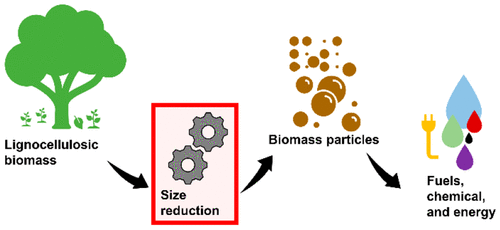当前位置:
X-MOL 学术
›
ACS Sustain. Chem. Eng.
›
论文详情
Our official English website, www.x-mol.net, welcomes your
feedback! (Note: you will need to create a separate account there.)
Understanding the Impact of Lignocellulosic Biomass Variability on the Size Reduction Process: A Review
ACS Sustainable Chemistry & Engineering ( IF 7.1 ) Pub Date : 2020-02-06 , DOI: 10.1021/acssuschemeng.9b06698 Oluwafemi Oyedeji 1 , Philip Gitman 2 , Jun Qu 3 , Erin Webb 1
ACS Sustainable Chemistry & Engineering ( IF 7.1 ) Pub Date : 2020-02-06 , DOI: 10.1021/acssuschemeng.9b06698 Oluwafemi Oyedeji 1 , Philip Gitman 2 , Jun Qu 3 , Erin Webb 1
Affiliation

|
The importance of size reduction to the commercial deployment of biomass utilization technologies cannot be overemphasized. Size reduction is necessary to create good flowing, easily digestible lignocellulosic biomass. However, inefficiencies and inconsistencies have not been well addressed for the process of size reduction. This has motivated quite a few research studies, some of which have reported the influence of process variables and pretreatment on the size reduction performance as well as the development of novel size reduction equipment and empirical mathematical models. In this Perspective, we present a systematic and critical evaluation of the state of lignocellulosic biomass size reduction research to provide insights for engineers and scientists for future development and investigation. We first briefly discuss the structural biology and failure mode of lignocellulosic biomass. Then, we present a comprehensive, data-driven picture of the interactions among lignocellulosic biomass attributes, size reduction process variables, pretreatment processes, and size reduction process performance (as defined by product characteristics and size reduction energy consumption). The sizing equipment tool wear issues are also summarized. Finally, we highlight some existing gaps and future research opportunities for lignocellulosic biomass size reduction to inform the development of newer technologies that could effectively produce high-value lignocellulosic biomass particles.
中文翻译:

了解木质纤维素生物量变异性对尺寸减小过程的影响:综述
减小尺寸对于生物质利用技术的商业应用的重要性不可过分强调。减小尺寸对于产生良好流动的,易于消化的木质纤维素生物质是必要的。但是,对于减小尺寸的过程,效率低下和不一致之处尚未得到很好的解决。这激发了许多研究,其中一些报告了工艺变量和预处理对尺寸减小性能的影响以及新型尺寸减小设备和经验数学模型的开发。在此观点中,我们对木质纤维素生物质尺寸减少研究的状态进行了系统的,关键的评估,以为工程师和科学家为未来的开发和研究提供见识。我们首先简要讨论木质纤维素生物质的结构生物学和破坏模式。然后,我们展示了木质纤维生物质属性,尺寸减小过程变量,预处理过程和尺寸减小过程性能(由产品特性和尺寸减小能耗定义)之间相互作用的综合数据驱动图。还概述了上浆设备工具的磨损问题。最后,我们重点介绍了降低木质纤维素生物质尺寸的现有差距和未来的研究机会,以指导开发可以有效生产高价值木质纤维素生物质颗粒的新技术。尺寸减小过程变量,预处理过程和尺寸减小过程性能(由产品特性和尺寸减小能耗定义)。还概述了上浆设备工具的磨损问题。最后,我们重点介绍了降低木质纤维素生物质尺寸的现有差距和未来的研究机会,以指导开发可以有效生产高价值木质纤维素生物质颗粒的新技术。尺寸减小过程变量,预处理过程和尺寸减小过程性能(由产品特性和尺寸减小能耗定义)。还概述了上浆设备工具的磨损问题。最后,我们重点介绍了降低木质纤维素生物质尺寸的现有差距和未来的研究机会,以指导开发可以有效生产高价值木质纤维素生物质颗粒的新技术。
更新日期:2020-02-07
中文翻译:

了解木质纤维素生物量变异性对尺寸减小过程的影响:综述
减小尺寸对于生物质利用技术的商业应用的重要性不可过分强调。减小尺寸对于产生良好流动的,易于消化的木质纤维素生物质是必要的。但是,对于减小尺寸的过程,效率低下和不一致之处尚未得到很好的解决。这激发了许多研究,其中一些报告了工艺变量和预处理对尺寸减小性能的影响以及新型尺寸减小设备和经验数学模型的开发。在此观点中,我们对木质纤维素生物质尺寸减少研究的状态进行了系统的,关键的评估,以为工程师和科学家为未来的开发和研究提供见识。我们首先简要讨论木质纤维素生物质的结构生物学和破坏模式。然后,我们展示了木质纤维生物质属性,尺寸减小过程变量,预处理过程和尺寸减小过程性能(由产品特性和尺寸减小能耗定义)之间相互作用的综合数据驱动图。还概述了上浆设备工具的磨损问题。最后,我们重点介绍了降低木质纤维素生物质尺寸的现有差距和未来的研究机会,以指导开发可以有效生产高价值木质纤维素生物质颗粒的新技术。尺寸减小过程变量,预处理过程和尺寸减小过程性能(由产品特性和尺寸减小能耗定义)。还概述了上浆设备工具的磨损问题。最后,我们重点介绍了降低木质纤维素生物质尺寸的现有差距和未来的研究机会,以指导开发可以有效生产高价值木质纤维素生物质颗粒的新技术。尺寸减小过程变量,预处理过程和尺寸减小过程性能(由产品特性和尺寸减小能耗定义)。还概述了上浆设备工具的磨损问题。最后,我们重点介绍了降低木质纤维素生物质尺寸的现有差距和未来的研究机会,以指导开发可以有效生产高价值木质纤维素生物质颗粒的新技术。











































 京公网安备 11010802027423号
京公网安备 11010802027423号